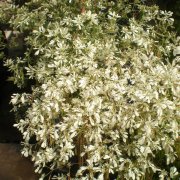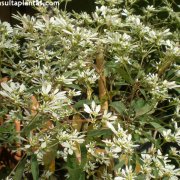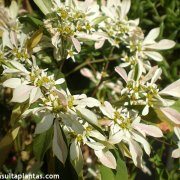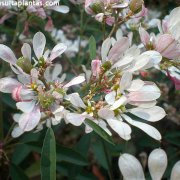Care of the plant Euphorbia leucocephala or Snows of Kilimanjaro |
|
The genus Euphorbia, family Euphorbiaceae, includes 2,000 species of succulents, trees, shrubs, and herbaceous plants of cosmopolitan distribution. Some species are: Euphorbia leucocephala, Euphorbia hypericifolia, Euphorbia piscatoria, Euphorbia lambii, Euphorbia piscatoria, Euphorbia regis-jubae, Euphorbia umbellata, Euphorbia pulcherrima, Euphorbia cotinifolia, Euphorbia milii, Euphorbia characias, Euphorbia dendroides, Euphorbia rigida, Euphorbia anachoreta, Euphorbia tithymaloides. Common names: Snows of Kilimanjaro, White Christmas bush, Snow bush, White lace euphorbia. This species is native to Central America. They are semi-woody shrubs with a rounded bearing that reach 3 meters (9.84 feet) in height. The leaves are evergreen, green and elliptical in shape. The white, star-shaped flowers appear in umbels surrounded by attractive white bracts (modified leaves). They bloom in fall and winter. Snows of Kilimanjaro is used to form informal hedges, in bushy groups, as isolated specimens and in large pots for terraces and patios. It's not recommended for gardens where there are children as they secrete an irritating latex if the branches break. Euphorbia leucocephala needs full sun exposure; in semi-shade it produces fewer flowers. It's a tropical plant that does not resist frost. The soil must be well drained and contain plenty of organic matter. Planting or transplanting is done after flowering. Water frequently with little water (never flood) and wait 2-3 days with the substrate dry before watering again. Snow bush resists drought but not excess moisture. Fertilize spring with compost and mineral fertilizer every 2 months during spring and summer. Prune after flowering to maintain a rounded appearance. White Christmas bush is a resistant plant to the usual pests and diseases. Euphorbia leucocephala propagates by seeds or by cuttings. |
Images of the plant Euphorbia leucocephala or Snows of Kilimanjaro |
Find plants
Euphorbia leucocephala or Snows of Kilimanjaro | Care and Growing
© 2025 FavThemes




